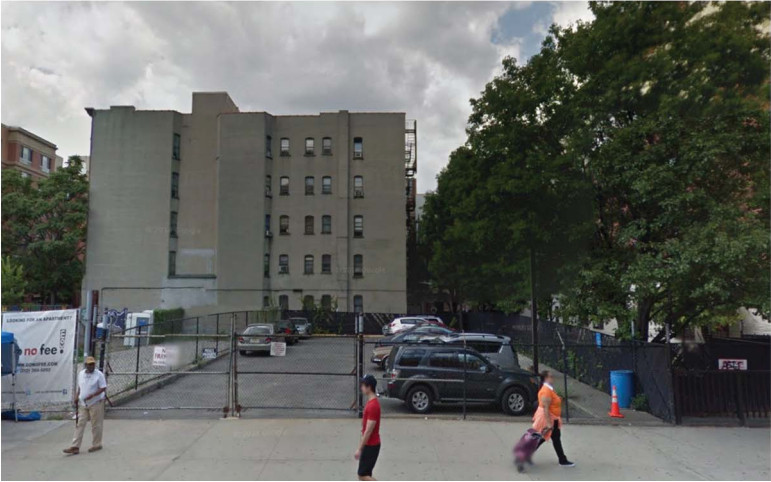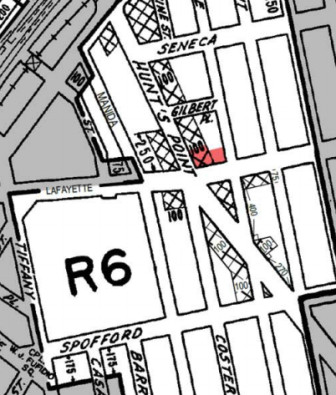
LiveOn
A parking lot next to a senior housing development on Frederick Douglass Boulevard could instead be a site for additional affordable residential units.
Unless asphalt and perpendicular white lines are your thing, parking lots don’t offer much to stir the imagination. But when the advocacy group LiveOn looks at the parking lot at 4112 Fort Hamilton Parkway in Borough Park, it sees not a drab square of blacktop but the senior housing of the future. Same goes for 23-50 Corporal Kennedy Street in Bay Terrace, Queens or 2177 Frederick Douglas Boulevard in Manhattan. Where there are now Accords, says the advocacy group, there could someday be apartments.
LiveOn in a recent report surveyed 191 parking lots associated with federally funded senior housing across the five boroughs and identified 39 parcels that are underused and could be turned into new apartments for the city’s growing gray population. The report cheers the efforts of the de Blasio administration to eliminate parking requirements that have long been imposed on new residential housing—a move that would permit they city’s senior housing operators to convert underused parking lots to residential use. According to LiveOn, the 39 sites it identified “could support an estimated 2,000 new affordable senior housing units.”
LiveOn focuses on senior housing, but advocates interested more generally in housing also cheer the city’s move to reduce parking requirements in high-density districts with ample mass transit options.
In a city that’s getting more crowded, where car ownership is lower than anywhere else in the country and where heat-absorbing, impermeable surfaces are increasingly seen as an environmental liability, relaxing parking requirements seems like it ought to be low-hanging fruit for the de Blasio administration, which is also seeking other zoning rule changes aligned with its ambitious affordable housing initiative.
But with the formal review process for the zoning rules yet to begin, the pushback has already started.
An editorial in a May edition of the Times Ledger in Queens called the rational behind the parking rules changes “hogwash” and noted that, “Civic leader Roe Daraio, president of the Communities of Maspeth and Elmhurst Together, thinks that parking should be increased rather than decreased.”
“The city seems to think that senior citizens could walk to public transportation, then either wait for a bus exposed to the weather – perhaps without a seat – or walk stairs to get to an elevated or subway train,” the editorial read. “Even if some seniors don’t drive, their visitors would probably drive.”
The following month the Norwood News reported on resistance to the parking rule change in the Bedford Park and Norwood sections of the Bronx. “People are desperately always looking for parking spaces,” Jean Hill, chair of Community Board 7’s Land Use/Zoning committee, was quoted as saying. Board 7’s chairwoman echoed the anxiety, according to the News: “This community is going up, we’re going to need more parking for the regular parking. The senior people do need cars to get around.” The local councilman, Andrew Cohen, said he’d oppose the change if community boards don’t rally around it, the newspaper reported.
According to Governing, 55.7 percent of New York households have no vehicle, making it the least car-owning city among the 798 the magazine surveyed. But their relatively small population hasn’t prevented car operators from derailing earlier policy proposals, like congestion pricing, that would have benefited the city’s far larger carless public. The spatial reality might be that New York City is mostly carless but still doesn’t have room for the cars that are here. The accompanying political reality is that car owners have political heft out of proportion to their numbers.

DCP/LiveOn
That red block on a Bronx zoning map is currently a parking lot but could become housing, according to a senior advocacy group.
Parking regulations inhibit affordable housing in two related ways: First, they gobble up some of the increasingly scarce land that might be used to create housing. And second, the cost of building and maintaining the lot eat into the money that could be used to subsidize the adjacent housing. Parking regulations are especially ill-suited for affordable housing because low-income people are less likely to own cars. Those that do drive are unlikely to be able to afford the fees to park in the lot next to their development, leaving the spaces underused and the housing operator unable to monetize them.
The city’s zoning proposal would “eliminate parking requirements for new affordable units and affordable senior housing in subway-accessible areas and where car ownership rates are lowest,” clarify parking requirements and reduce them for senior-housing sites elsewhere in the city and establish a mechanism for owners of existing developments to turn parking lots into new housing. It would also “allow affordable senior housing developments with existing parking facilities in these areas to eliminate their parking facilities.”
But New York City isn’t the final word on what existing senior housing developments can do with their parking lots. The LiveOn report notes that the federal Department of Housing and Urban Development, which has in the past funded almost all senior housing, requires housing operators to go through a complicated process and clear a high threshold before they can get permission to alter HUD-sponsored property.
Claire Hilger, who oversees the extensive senior-housing portfolio for Catholic Charities Brooklyn and Queens, notes that parking lots need not become housing to be more useful to the aging New Yorkers they are intended to serve. They could be turned into gardens or recreation areas—although building more housing next to existing senior buildings would create economies of scale, because the existing management could operate the additional units and services could be shared.
Not every parking lot is appropriate for housing. It depends on the shape, size, street frontage and other factors. And even underused lots do tend to serve a few seniors; federal rules mandate that any changes hold those seniors harmless, perhaps by preserving the handful of utilized spaces or offering parking offsite.
The bottom line, says Hilger, is that the current zoning set-up doesn’t reflect the residents’ needs. “We have thousands and thousand of people on waiting lists for apartments,” she says of the 25 buildings under her watch “I don’t have a single full parking lot.”









8 thoughts on “Battle Brewing Over Proposed Changes to City Parking Rules”
Pingback: Today’s Headlines | Streetsblog New York City
Enough seniors drive cars or have visitors that drive cars that the city should maybe just leave this alone. Even enough ‘affordable’ housing residents will have cars to require some on site parking. What about the tenants currently using the parking lots? They’d be dumped out into the street fighting for Alternate Side Parking spaces. Drivers might be a numerical minority in NYC, but they are the middle class and above. They use their cars to shop, visit friends and contribute to the NYC economy. The local opposition to this tells me it’s another dumb deBlasio idea.
BTW 1 and 2 family homes also have parking requirements – usually one space per unit.
Like NNY said but more so. Forgotten yet proven by studies repeatedly(but usually ignored/surpressed by the anti-car bunch): the prime reason for paying the great price of maintaining a privately-owned-vehicle(POV) in NYC is: I NEED IT TO GET TO MY GOOD-PAYING JOB BECAUSE PUBLIC TRANSIT DON”T GO THERE! Access to a car doubles one’s chances of getting a job(proven). Access to a car triples the likelihood of greater income from that job(proven).
If a car cost $9,000/year to keep then it is logical that the owner earns that $9,000/year AND MUCH MORE to offset that personal cost.
Commuting by POV requires a storage spot at the start-point and at the destination. In a built-up environment that means accessible, affordable and sufficient parking, or else the owner goes to somewhere else(‘burbs?) and the city’s economy begins to collapse.
Am I getting through to you?
All the public meetings I have attended with CPC and around Brooklyn on the Mayor’s Plan, the parking part is a non-starter.
It’s logical that the owner earns “much more” to offset the cost? Lolol
Its plain and clear; not everyone can take public transport. I am a senior with a car who is unable to take public trans or walk
everywhere (like I used to) as I got hit by a car while crossing the Westside highway as
a pedestrian and I have chronic knee and back damage. I also take my
dogs to work with me everyday. And I have a business that requires lots of deliveries of small goods.
A major issue is that there is not enough affordable parking in the city. A parking ticket judge told me long ago when she said that if the city wanted to limit car congestion on all levels, they could limit the number of cars registered. As long as they register unlimited cars, there are unlimited opportunities for police to write tickets and the city to make income and that is why the city will not limit the number of cars registered. We parking ticket payers call it the unnamed city tax.
. There is not enough parking on the lower east side Manhattan , two bridges area – not to mention very limited public transport. And it gets worse every day for various reasons. The parking lots in my mitchell lama coop cost 35.00 a month and it is 275.00 a month in the nearest paid paring lot, which is full. It takes 12 years to get a parking space and much less time get an apartment because the older people in my co-op are dying in numbers. And there are people making money on their 35.00 month parking space.
The city needs to look at parking on a zone by zone basis and not change a city wide rule to benefit some few situations. They should start by looking at which areas pay the most parking tickets. These areas should get city parking structures with reasonable parking fees.
People need their cars, not everyone can or wants to, take public transport.
Yes!! See Tom’s comment below.
Taking parking away from seniors is discriminatory.
The notion that those of low income are less likely to need off street parking is absolutely absurd. What about the independent taxi drivers and others who have to use vehicles for work? And what about the many residents who don’t have the luxury of walking to doctor, bank, or to a grocery store with affordable prices within blocks of their residence? The notion about the low income residence not needing their cars reflects an ignorance about the nature of working class jobs in this city.
Seems to me that this latest attempt to identify sites for housing–while perhaps well meaning and necessary– will only intensify urban fragmentation and diminish quality of life. It also appears to reflect a certain class bias of well entrenched housing interests who are simply looking for the next development deal to feed their own coffers.